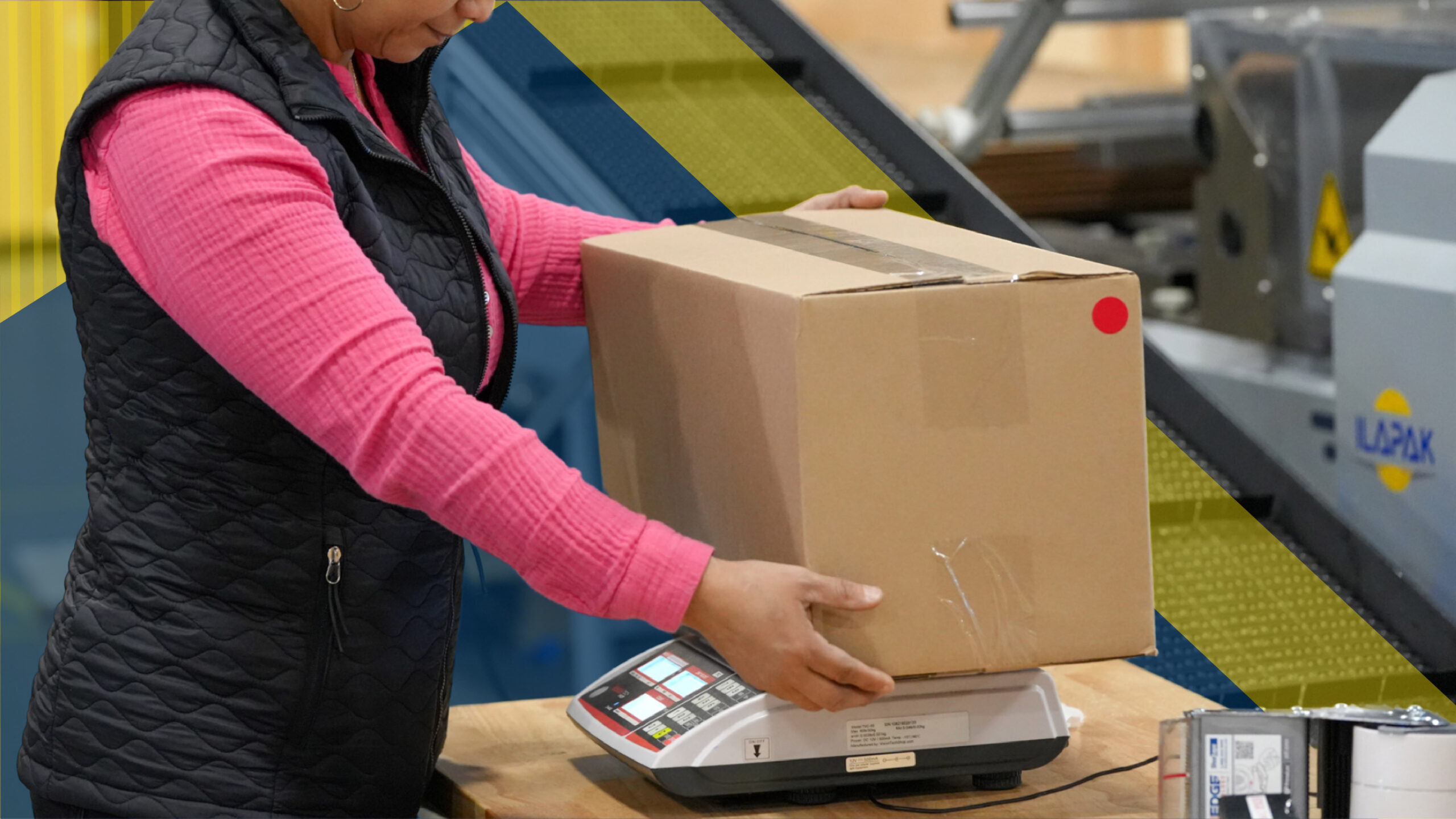When determining the pricing for a shipment, one of the major considerations is dimensional (DIM) weight. Whether you’re handling shipping logistics independently or passing the task to a third-party provider, grasping this concept is crucial for getting a fair price. However, DIM weight isn’t just a calculation of physical weight; it adds complexity to calculating the final shipping cost. In this article, we will provide insight into dimensional weight, how to calculate it, and how it relates to cost savings.
What Is DIM Weight?
Dimensional weight (also known as DIM weight or volumetric weight) is a pricing technique used in shipping and freight services. It’s a method to account for the space a package occupies in relation to its actual weight. Dimensional weight is calculated by multiplying the package’s volume (in inches) and then dividing by a dimensional factor (DIM Factor), typically provided by the carrier. This DIM factor represents the amount of space one unit of weight occupies in the carrier’s transportation network.
Dimensional Weight Formula
DIM weight ensures that carriers are fairly compensated for the space that large lightweight packages take up in their vehicles and planes. It also incentivizes shippers to pack their goods efficiently to minimize wasted space.
Example
If a package measures 20 × 15 × 10 inches, and the DIM factor is 139:
\[ \frac{(20 \times 15 \times 10)}{139} = 21.58 \]
Most carriers round up to the next whole number, making the DIM weight 22 lbs.
Steps To Calculating DIM Weight
To calculate dimensional weight, follow these steps:
- Measure the Package and Calculate Volume: Measure the length, width, and height of the package in inches. Make sure to measure the outermost dimensions of the package. Then multiply those dimensions together to get the volume
- Find the Carrier’s Dimensional Factor: Obtain the dimensional factor provided by the carrier you’re using for shipping. This factor represents the amount of space one unit of weight occupies in the carrier’s transportation network.
- Calculate the Dimensional Weight: Divide the volume of the package by the carrier’s dimensional factor to determine the dimensional weight.
- Compare Actual Weight and Dimensional Weight: Compare the dimensional weight obtained in Step 4 with the actual weight of the package. The carrier will charge based on whichever weight is greater.
DIM Weight vs Actual Weight
The primary difference between dimensional weight and actual weight is how you calculate the final weight:
Actual Weight: As you might expect, actual weight is simply the physical weight of your package that you get by weighing it on a scale.
Dimensional Weight: As we’ve learned previously, DIM weight is a theoretical weight that is based on how much space a package takes up during shipping.
As we now know, carriers will compare the actual weight of the package to its dimensional weight, and they will charge you based on whichever is greater. This means that if you have a large but lightweight package, you might end up paying for the space it occupies rather than its actual weight, which could be significantly less.
What Factors Determine DIM Weight?
Several factors determine DIM weight, including:
- Package Dimensions: The length, width, and height of the package are crucial factors in calculating dimensional weight. Larger dimensions result in higher dimensional weight.
- Carrier’s Dimensional Factor: Each carrier has its own dimensional factor, which represents the amount of space one unit of weight occupies in its transportation network. This factor is provided by the carrier and is used in the DIM weight calculation formula.
- Packing Efficiency: How efficiently the items are packed within the package also affects DIM weight. Poorly packed items that result in wasted space can lead to higher dimensional weight.
- Void Fill & Dunnage: Void fill & dunnage relate closely to packing efficiency. Stuffing a box full of packing material that is unnecessary can lead to you paying for more space than necessary. You should find the right materials that will protect your products and only pack the box with exactly how much you need.
- Destination and Shipping Method: Some carriers may apply different dimensional factors or rules depending on the destination and shipping method.
Other DIM Weight Calculations
Carrier-Specific DIM Weight Calculations
Each shipping carrier uses slightly different DIM factors depending on the service level:
UPS
- Domestic: 139
- International: 166
FedEx
- All shipments: 139
DHL
- Uses 5000 as the divisor when dimensions are in centimeters.
USPS
- Applies DIM weight to Priority Mail packages over 1 cubic foot (1,728 in³) using a DIM factor of 166.
Air Freight vs. Ground DIM Weight
For air freight, the calculation is typically:
\[ \frac{\text{Volume (in cubic inches)}}{166} \]
For ground shipments, the divisor is often higher (e.g., 139), leading to a slightly higher DIM weight.
Retail vs. Commercial DIM Weight Calculations
Some shipping accounts with bulk discounts may have customized DIM factors. Large-volume shippers often negotiate with carriers to get a more favorable DIM divisor, lowering their shipping costs.
International DIM Weight Calculation
International shipments typically use metric measurements and different divisors. For example:
\[ \frac{\text{Volume (cm}^3\text{)}}{5000} \]
This means a box that measures 50 × 40 × 30 cm would have a DIM weight of:
\[ \frac{50 \times 40 \times 30}{5000} = 12kg \]
E-Commerce Considerations
Online retailers must optimize packaging to reduce DIM weight costs. Strategies include:
- Using smaller boxes or poly mailers when possible.
- Selecting carriers with favorable DIM factors for their products.
- Negotiating with carriers for better DIM pricing.
How Can Optimizing DIM Weight Save A Business On Shipping Costs?
Optimizing DIM weight can lead to significant cost savings, especially for businesses that ship high volumes. The exact savings depend on factors like shipping frequency, package size, carrier rates, and fulfillment methods. Here’s a breakdown of potential savings:
DIM Weight vs. Actual Weight: The Cost Difference
Carriers charge based on whichever is higher: actual weight or DIM weight. If your package has a large volume but is lightweight, you’re paying extra for wasted space.
Example: Cost Comparison
Let’s say a business ships 1,000 packages per month with these specs:
- Old Packaging: 20 × 15 × 10 inches (30 lbs DIM weight)
- Optimized Packaging: 18 × 12 × 8 inches (18 lbs DIM weight)
- Carrier Rate: $0.50 per lb
💰 Cost Before Optimization:
- 1,000 packages × 30 lbs × $0.50 = $15,000/month
💰 Cost After Optimization:
- 1,000 packages × 18 lbs × $0.50 = $9,000/month
🔻 Savings: $6,000 per month ($72,000 per year!)
Savings by Using Smaller or Alternative Packaging
✅ Poly Mailers Instead of Boxes: If an item fits in a poly mailer instead of a bulky box, DIM weight doesn’t apply, reducing shipping costs by 20-50%.
✅ Custom-Sized Boxes: Using a custom box instead of a standard box can reduce wasted space and DIM weight charges by 10-30%.
✅ Vacuum Sealing Soft Goods: Reducing package volume by 30-50% can lower DIM weight significantly.
Long-Term Business Impact
For businesses shipping 10,000+ packages per year, optimizing DIM weight can result in six-figure savings annually. If your company is paying excessive DIM fees, negotiating with carriers, redesigning packaging, and choosing the right service can dramatically lower costs.
How Should I Pack A Shipment To Get The Most Cost-Effective DIM Weight?
Packing efficiently to minimize DIM weight is all about reducing wasted space while protecting your items. Here are the best strategies to optimize packaging:
Choose the Smallest Possible Box
- Use a box that snugly fits your product to avoid unnecessary dimensional charges.
- If you’re shipping multiple items, arrange them tightly together instead of using a larger box with extra padding.
Use Poly Mailers or Envelopes When Possible
- If your item isn’t fragile, consider poly mailers, padded envelopes, or shrink wrap instead of a box.
- Carriers typically charge DIM weight only for boxed shipments, so avoiding boxes can sometimes reduce costs.
Select a Box with the Right Shape
- Some shipping carriers round up dimensions (e.g., 12.1 inches becomes 13 inches).
- Avoid unnecessary height—flat, compact boxes are often more DIM-efficient.
Use Compression Packing Materials (Also Referred to as Void Fill)
- Instead of bulky packing peanuts or air pillows, use thin, protective padding like bubble wrap sheets or foam rolls.
- Vacuum-seal soft items (like clothing or blankets) to reduce volume.
Optimize Box Strength vs. Size
- Lightweight corrugated boxes provide protection without adding excess weight.
- Avoid using oversized boxes just because they are readily available.
Stack Items Efficiently
- Place items in tight arrangements to prevent shifting and reduce void space.
- If necessary, use custom inserts or dividers to keep items compactly packed.
Check Carrier-Specific DIM Factors
- Compare different carriers’ DIM factors (e.g., 139 vs. 166) to see which gives you the lowest charge.
- Some carriers round up, while others use fractional rounding—check their policies.
Consider Custom Packaging
- If you ship frequently, invest in custom-sized boxes to minimize extra space and DIM charges.
- Many fulfillment centers offer packaging customization to reduce shipping costs.
Use Multi-Depth Boxes
- These boxes allow you to cut down to size, eliminating wasted space while maintaining protection.
Test Before Shipping
- Weigh and measure your package before finalizing shipment to ensure you’re getting the best rate.
- If using a fulfillment service (e.g., Amazon FBA), check their packing guidelines to avoid unnecessary fees.
If your company is paying excessive DIM fees, negotiating with carriers, redesigning packaging, and choosing the right service can dramatically lower costs.
What is Void Fill?
Void fill, which is also referred to as packing material or packing filler, are the materials used to fill empty spaces or voids in packaging to protect the contents during shipping and handling. The primary purpose of void fill is to prevent items from shifting, rattling, or being damaged while in transit. Common types of void fill materials include:
- Bubble Wrap: Bubble wrap consists of plastic sheets with air-filled bubbles providing cushioning and protection against impacts.
- Packing Peanuts: Packing peanuts are small, lightweight foam pieces that fill empty spaces in packages, helping prevent any unnecessary movement.
- Air Pillows: Air pillows are inflated plastic cushions that fill voids in packages. They are lightweight and provide protection.
- Paper Fill: Crumpled paper or shredded paper can be used to fill empty spaces in packages. It is an environmentally friendly option that still provides protection to products.
- Foam Inserts: Custom-cut foam inserts can be used to provide precise protection for very fragile items.
- Foam-in-Place Packaging: This involves spraying expanding foam into the package, which then hardens to form a custom-fit protective layer around the item.
The choice of void fill material depends on factors such as the fragility of the items being shipped, the size and weight of the package, environmental concerns, and cost considerations. It can be hard to decide on which void fill might be best for your products, but by working with a 3PL, you can cut out the guessing and work with a partner that can quickly point you to the right materials.
How Working with a 3PL Partner can Reduce Costs for Packages
3PLs can provide lower shipping rates to customers in many different ways. And by being experts at optimizing packages and packing materials, they can almost always get you the lowest shipping costs out of the door. Here are some of the main ways 3PLs lower expenses for customers:
- 3PLs Have Expert Packaging Knowledge: 3PLs often have expertise in optimizing packaging solutions. They can recommend packaging materials and techniques that minimize empty space within packages, reducing DIM weight. By using the right-sized packaging and efficient packing methods, they can help lower DIM weight and associated costs.
- They Provide Custom Package Solutions: 3PLs can provide custom packaging solutions tailored to your specific products and shipping requirements. Custom packaging can help eliminate excess space and reduce the need for additional void fill materials, leading to lower DIM weight and packing costs.
- They Leverage Their Volume to Get Discounts: 3PLs often have partnerships with packaging suppliers and carriers, allowing them to negotiate volume discounts on packaging materials and shipping rates. These discounts can help reduce overall packing and shipping costs for businesses.
- 3PLs Keep Track of Carrier Rates: Carriers have the ability to tweak their DIM factor and shipping rates at will, potentially leaving businesses vulnerable to higher costs. However, partnering with a 3PL ensures businesses stay ahead of any carrier rate changes, guaranteeing access to the most favorable rates for their customers.
What Are Some Resources For Businesses Who Want To Reduce DIM Weight Costs?
Reducing DIM weight costs requires a combination of the right tools, strategies, and carrier partnerships. Here are some valuable resources that businesses can use to optimize their shipping efficiency:
Shipping Cost Calculators & DIM Weight Tools
Many carriers provide online calculators to help businesses estimate DIM weight costs before shipping.
Carrier DIM Weight Calculators
- UPS: UPS Dimensional Weight Calculator
- FedEx: FedEx Dimensional Weight Calculator
- USPS: USPS Pricing Calculator
- DHL: DHL Volumetric Weight Calculator
Tip: Compare multiple carriers to find the best DIM factor for your specific packages.
Custom Packaging & Eco-Friendly Alternatives
- Uline (uline.com) – Offers a variety of box sizes and shipping supplies.
- Packsize (packsize.com) – Creates on-demand custom packaging to fit products precisely.
- EcoEnclose (ecoenclose.com) – Sustainable and space-efficient shipping materials.
- Pregis (pregis.com) – Provides protective packaging solutions that optimize space.
Tip: Consider multi-depth boxes that adjust in height to minimize wasted space.
Third-Party Logistics (3PL) & Fulfillment Services
Many businesses use 3PL services to take advantage of bulk shipping discounts and optimized packing techniques.
- ShipBob (shipbob.com) – Offers optimized fulfillment with cost-effective packaging.
- ShipMonk (shipmonk.com) – Provides automated shipping optimization to reduce costs.
- Rakuten Super Logistics (rakutensl.com) – Specializes in e-commerce fulfillment with optimized DIM weight strategies.
- Nautical Manufacturing and Fulfillment (nautical-direct.com) – Has negotiated carrier rates that can save shippers a lot.
Tip: A good 3PL provider can negotiate better DIM factors and consolidate shipments to save costs.
Shipping Discount Platforms
- ShipStation (shipstation.com) – Helps compare carrier rates and reduce shipping costs.
- EasyPost (easypost.com) – Offers discounted rates and automation tools.
- Pirate Ship (pirateship.com) – Provides USPS and UPS discounts with no extra fees.
- Shippo (goshippo.com) – Access discounted shipping rates from multiple carriers.
Tip: If you ship thousands of packages per year, contact carriers directly to negotiate lower DIM weight pricing.
Logistics & Shipping Consultants
If your business ships large volumes, hiring a logistics consultant can help optimize your supply chain and reduce DIM weight fees.
- Reveel (reveelgroup.com) – Helps businesses analyze and reduce shipping costs.
- Shipware (shipware.com) – Specializes in carrier contract negotiation and cost reduction.
- Transportation Impact (transportationimpact.com) – Works with businesses to lower parcel shipping expenses.
Tip: These services audit your shipping invoices and help negotiate lower DIM factor rates.
Choose Nautical to Ensure Your Products are Optimized
With our packaging and shipping expertise, we’re here to help you save money wherever we can. By working closely with our customers, we’ve learned how to pack items more efficiently, and find the right protection for all different types of products. We focus on providing customized solutions that streamline your shipping needs while keeping costs low. Whether you’re a small business or a large company, our team is dedicated to offering our expert services at an affordable price.
DIM Weight Frequently Asked Questions
Why is DIM Weight Used by Carriers?
DIM weight ensures that carriers are fairly compensated for the space occupied by packages in their transportation network. Without DIM weight pricing, carriers might lose revenue on large but lightweight packages that take up significant space in their vehicles or planes.
What Is Volumetric Weight?
Volumetric weight is another name for dimensional weight! Nothing in the process changes, you still divide the package’s volume by the carrier’s DIM factor to determine the volumetric weight.
When Should I Think of DIM Weight?
You should primarily be considering DIM weight when you are determining the right box for your packages. Since box dimensions are the primary factor for DIM weight, you want to find the smallest box that you can safely transport your product in. This will lead to cost savings and fewer wasted materials.




